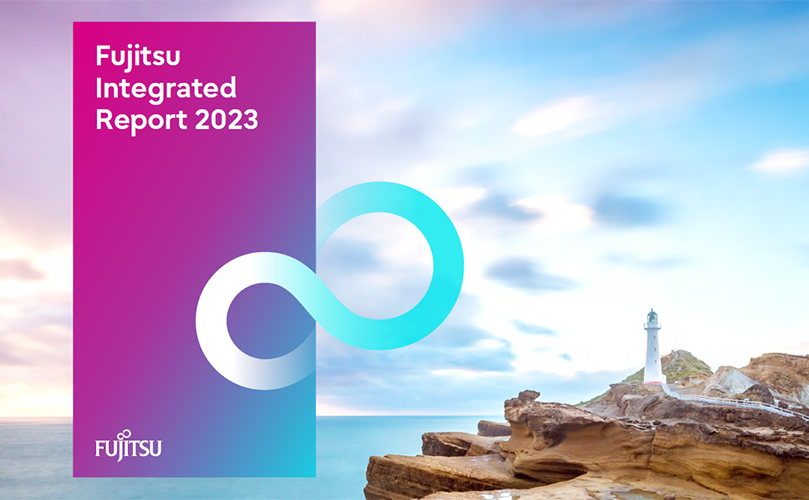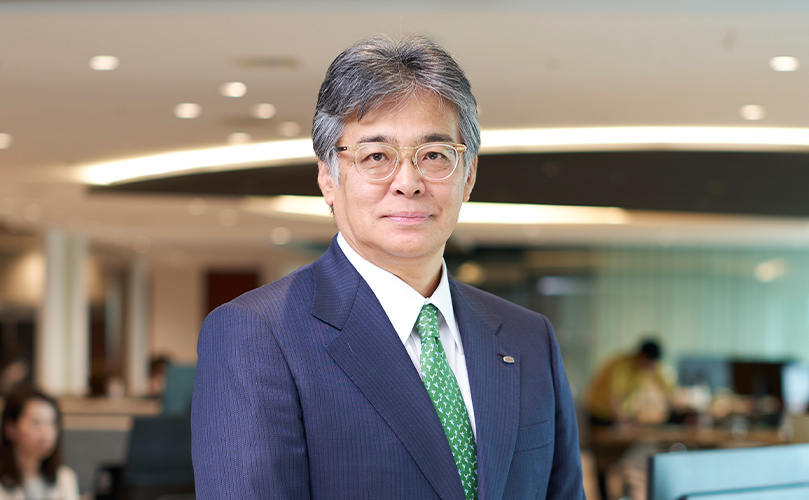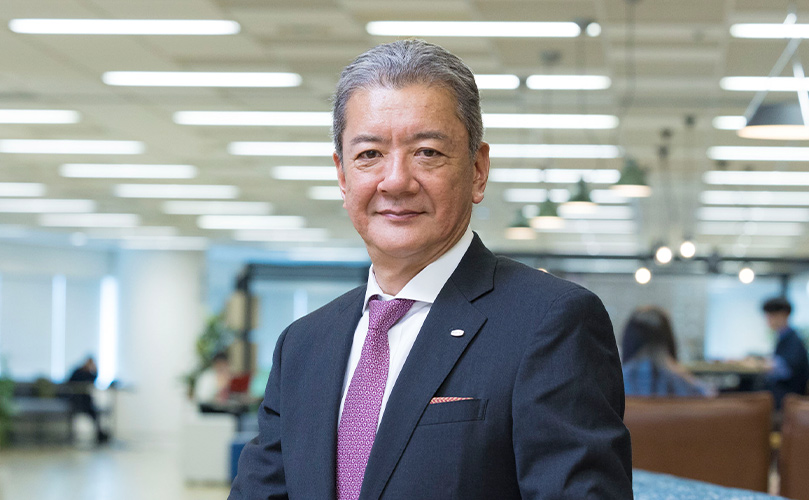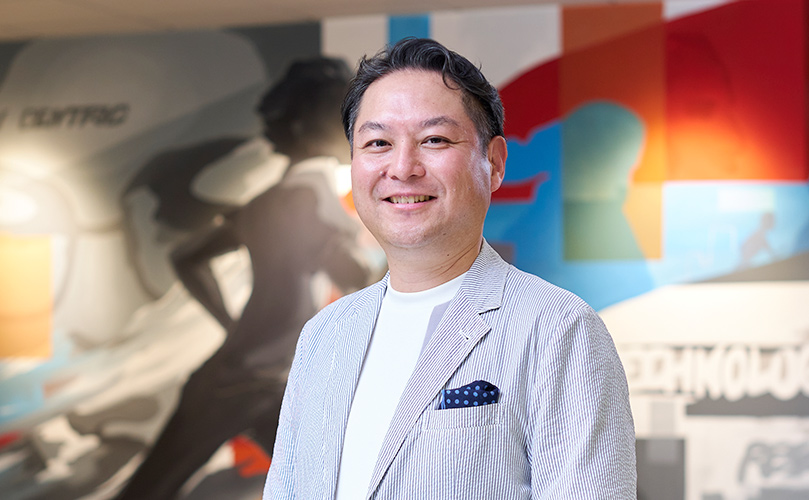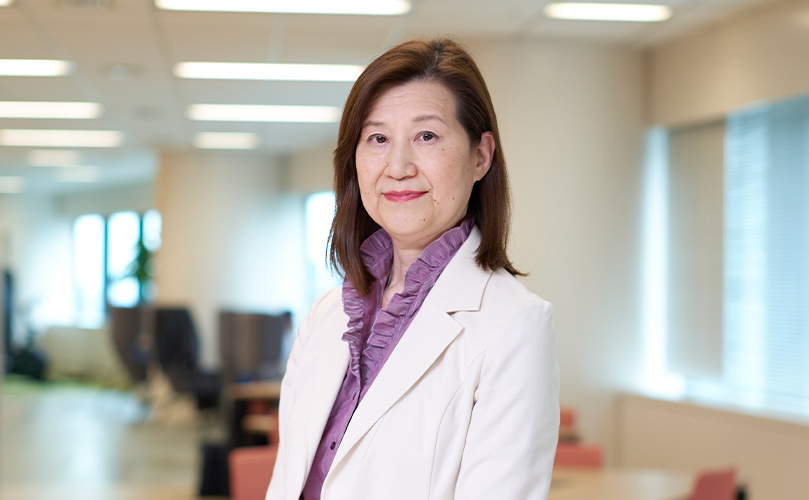Human resource management
Hiroki Hiramatsu
Corporate Executive Officer EVP, CHRO
Message from the CHRO

By increasing the self-starting job mobility of employees who take career ownership,
we will create a workforce portfolio that dovetails with our business strategies and helps enhance corporate value.
Implementing human resource management transformation to realize Our Purpose
In 2019, the Fujitsu Group declared that it will become a “DX company” that leads the digital transformation of its customers. In 2020, we updated the Fujitsu Way, putting Our Purpose at the apex. To realize Our Purpose as a DX company, we had to think about what changes individuals and organizations needed to make. The HR department discussed this question with the CEO and other members of the management team to formulate our HR vision, to be a “DX company where diverse talent gathers to create innovation everywhere in society.” During the past three years, we have been pushing forward with human resource management transformation to realize this vision.
One key initiative of these reforms was our introduction of job-based human resource management. This system requires clear definition of the responsibilities, authority, and talent requirements associated with specific jobs, and allocating personnel accordingly. We have gradually adapted this type of system in Japan, which is commonly used in other countries. In addition, we have significantly revised our education, performance management, and compensation systems. With this overhaul we aimed to raise employees’ awareness of taking charge of their own career development. We sought to recast the relationship between the Company and its employees, and to transform the organizational culture more broadly.
Building a workforce portfolio aligned with our business strategies
Through fiscal 2022, we focused on carrying out comprehensive transformation that involved the development of various systems. In fiscal 2023, we are building a workforce portfolio aligned with the business strategies outlined in the 2023–2025 Medium-Term Management Plan (the new medium-term plan). Specifically, we are working with our business divisions to determine the workforce portfolio that we require to transform our business portfolio. Our considerations are based on a globally unified set of roles under the resource strategy outlined in the new medium-term plan. In these discussions, we are focusing on questions including how our transformation will enable our workforce portfolio to support our business portfolio three years hence, and even into 2030. We will clarify our current situation and define our ideal state (where we desire to be). We will then calculate the workforce needed for each role, and begin planning and implementing recruitment and training programs to realize this ideal state.
This approach to human resource management differs markedly from the traditional method of annual workforce planning and operation based on interviews with business divisions. The new approach represents a considerable challenge for the HR department, as we now need to contribute to the strategies of the business units. However, we see this as an unprecedented opportunity to establish a framework for investment in the acquisition and training of talent from a medium- to long-term perspective toward our ideal state for 2030, based on our Materiality.
Two approaches to realize our ideal state
Once we have established a clear quantitative framework for our future workforce portfolio, the next step is to understand the gap between where we are now and where we wish to be, plan how to fill the gap, and then proceed to approach this ideal state. We believe this process will require a combination of top-down and bottom-up approaches.
In the top-down approach, we will use a reskilling program to help designated personnel acquire the knowledge and skills necessary for specific roles. A forerunner to this initiative was a reskilling program we conducted in fiscal 2020, which transformed approximately 8,000 sales employees into business producers. We now also plan to take a top-down approach to running development programs, and with a sense of urgency, for major portfolio transformations such as strengthening consulting resource offerings capable of delivering in Fujitsu Uvance’s Vertical areas or expanding specialized resources to enhance delivery.
At the same time, we believe that the act of clearly establishing a future workforce portfolio is a means of adopting a bottom-up approach. As the Group defines its workforce portfolio more clearly, employees will better understand which skills they need to acquire in the future. In this way they will be able to see which skills will offer them new opportunities and contribute to their own growth and success.
Career ownership and self-starting job mobility as keys to building a robust workforce portfolio
Workforce mobility represents a key in building a workforce portfolio that aligns with our business objectives and allows for agile adjustments based on the progress of and changes in our strategies. In addition to ensuring workforce mobility through systematic placement and transfer of talent, we believe it is crucial to foster employee initiative and self-starting job mobility, as this helps create value within the Group. As an example, consider a project that is critical to the execution of our business strategies. Selecting team members from among multiple candidates who express the desire to be involved makes it easier to form a highly skilled and motivated team. However, if the pool of employees volunteering for such an opportunity is small and lacks diversity, a bottom-up approach will eventually become ineffective. To help the bottom-up approach function well, we emphasize the importance of career ownership, in which employees shape their own careers.
Over the past two years, we have seen a significant upswing in the number of people taking advantage of our internal job-posting (internal recruitment) system to volunteer for transfers and promotions tailored to their desired career plans. This change is meaningful because it allows us to create a workforce portfolio based on greater employee mobility. The number of people using the job-posting system has increased, and more employees have inspired colleagues and supervisors to utilize the system, encouraging others to take action in developing their careers. We believe the Group’s organizational culture will change further as a result, reinforcing the dynamic interplay between business strategies and the workforce portfolio.
Evolving as a competitive company with high employee engagement
The effects of personnel and organizational transformation can also be seen in the employee engagement survey results. Under the previous Medium-Term Management Plan, we set 75 as our target value. In fiscal 2022, we reached 69, which was below our target but was six points higher than in fiscal 2019 when we started conducting the survey.
Our analysis of survey results suggests that communication with managers strongly affects engagement. As talent mobility increases, it is important for companies to enhance employee engagement and create an environment where employees feel motivated to take on challenges and believe they can grow within the organization. Keeping this in mind, we encourage managers to regularly engage in 1-on-1 meetings with their team members. We also provide managers with knowledge and tools to facilitate smooth communication.
In April 2023, we revised our compensation of employees in Japan to bolster our competitiveness in talent acquisition, ultimately enabling us to provide sustained value to our customers as a global DX company. Employees’ monthly wages were raised by 10% on average. By raising compensation levels and creating an environment that fosters growth, we aim to heighten engagement and strengthen the link between our business strategies and our workforce portfolio. We will also continue working to transform employees’ mindsets and our organizational culture, contributing to the Group’s growth and elevating our corporate value.
Hiroki Hiramatsu
Corporate Executive Officer
EVP, CHRO
* Human Resource


